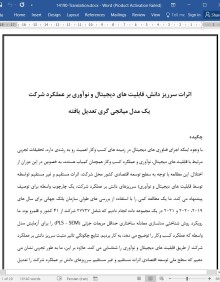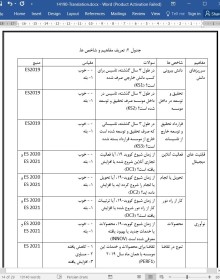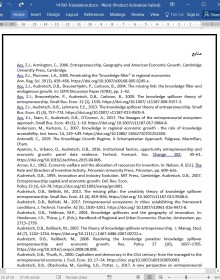
دانلود مقاله اثرات سرریز دانش، قابلیت های دیجیتال و نوآوری بر عملکرد شرکت
چکیده
با وجود اینکه اجرای فناوری های دیجیتال در زمینه های کسب وکار اهمیت رو به رشدی دارد، تحقیقات تجربی مرتبط با قابلیت های دیجیتال، نوآوری و عملکرد کسب وکار همچنان کمیاب هستند، به خصوص در این دوران از اختلال. این مطالعه با توجه به سطح توسعه اقتصادی کشور محل شرکت، اثرات مستقیم و غیر مستقیم (واسطه توسط قابلیت های دیجیتال و نوآوری) سرریزهای دانش بر عملکرد شرکت، یک چارچوب واسطه برای توصیف پیشنهاد می کند. ما یک مطالعه کمی را با استفاده از بررسی های طولی سازمان بانک جهانی برای سال های ۲۰۱۹، ۲۰۲۰ و ۲۰۲۱ در یک مجموعه داده انجام دادیم که شامل ۲۷۷۲۷ شرکت از ۴۱ کشور و قلمرو بود. ما رویکرد روش شناختی مدلسازی معادله ساختاری حداقل مربعات جزئی (PLS - SEM) را برای آزمایش مدل واسطه که عملکرد کسب وکار را توضیح می دهد، به کار بردیم. نتایج چگونگی تاثیر مثبت سرریز دانش بر عملکرد شرکت از طریق قابلیت های دیجیتال و نوآوری را شناسایی می کند. علاوه بر این، ما به طور تجربی نشان می دهیم که سطح ملی توسعه اقتصادی اثرات مستقیم و غیر مستقیم سرریزهای دانش بر عملکرد شرکت را تعدیل می کند.
1. مقدمه
فعالیت های کارآفرینی به رشد اقتصادی کشورها و مناطق کمک می کند و ساخت مزیت های رقابتی ملی (کری و توریک، 2003؛ ون استل و همکاران، 2005؛ آپاریسیو و همکاران، 2016) را از طریق کاهش نرخ بیکاری (آدرتش و توریک، 2000) و ایجاد تغییرات مثبت مسلم در چارچوب اجتماعی - اقتصادی تقویت می کند (یوسف و همکاران، 2018). در نتیجه کارآفرینی به عنوان یک عامل حیاتی برای رفاه و رونق اقتصادی و در نتیجه ماهیت اساسی سیاست های حمایتی متنوع زیربنای سرمایه گذاری های کارآفرینانه شناخته می شود (اکس و همکاران، 2017؛ آدرچ و بلیتسکی، 2017). زمانی درک فعالیت های کارآفرینی مهمتر می شود که علیرغم همه نتایج اشاره به ارتباط آن ها، نرخ موفقیت راه اندازی شرکت های جدید نسبتا پایین باقی می ماند، به خصوص در اقتصادهای مبتنی بر دانش (GEM، 2020).
اخیرا ادبیات تحقیق نظریه سرریز دانش (KST) را برای توضیح ظاهر کارآفرینان گسترش داده است (بلیتسکی و همکاران، 2016؛ کایازا و همکاران، 2020). اکنون KST یک سنت طولانی دارد که بر اهمیت دانش به عنوان یک منبع رشد اقتصادی تاکید می کند (آرو، 1962؛ رومر، 1990؛ آدرتش و کیلباخ، 2007). با این حال، همه دانش ایجاد شده موضوع اکتشاف نیست (اکس و همکاران، 2013) و دقیقا این دانش "آزاد شده" است که نیاز به انتقال به کارآفرینانی دارد که ممکن است سپس آن را در سرمایه گذاری های جدید به کار گیرند. بنابراین، سرریزهای دانش، در انتقال دانش خود قادر به تبدیل به فرصت های کسب وکار جدید هستند که خود به عنوان عوامل اصلی در فرآیندهای کارآفرینی درک می شوند (آدرتش، 2007).
در حال حاضر شرکت ها نیز بیش از پیش از نیاز به تطبیق با چالش های نوظهور آگاه هستند (لوریرو و همکاران، 2021). در نتیجه سرریزهای دانش نقش مهمی را در بهینه سازی و بهبود سطح بهره وری فرآیندهای شرکت از طریق تقویت مهارت های دیجیتال به منظور تضمین عملکرد بهتر کسب وکار ایفا می کنند (هردیا و همکاران، 2022). درنتیجه در یک محیط متغیر و متلاطم، قابلیت های دیجیتال نقشهای مهمی را ایفا می کنند (ژن و همکاران، 2021).
6. ملاحظات نهایی، محدودیت ها و خطوط آینده تحقیق
این مطالعه یک چارچوب واسطه برای توصیف، با توجه به سطح توسعه اقتصادی ملی کشور میزبان شرکت، اثرات مستقیم و غیر مستقیم (واسطه توسط قابلیت های دیجیتال و نوآوری) سرریزهای دانش شرکت ها در سطوح مربوطه عملکرد آن ها پیشنهاد کرد.
نتایج ما تاثیر مثبت سرریزهای دانش بر عملکرد و نوآوری را نشان می دهد که اهمیت محض سرریزهای دانش را برای ایجاد ارزش توسط شرکت ها منعکس می کند. ما همچنین بررسی می کنیم که چگونه قابلیت های دیجیتال که برای شیوه های نوآوری اساسی هستند، به خودی خود قادر به تولید این تاثیر بدون توسل به خطاهای دانش نیستند. از این رو نیاز به انتقال دانش با دانش از قبل موجود یا با دانش جدید، به منظور تحریک ظرفیت و حتی شیوه های لازم برای نوآوری وجود دارد. ما همچنین نتیجه می گیریم که سطح توسعه اقتصادی تاثیر تعدیل کننده مثبتی بر رابطه بین سرریزهای دانش و نوآوری و عملکرد دارد. این امر نشان می دهد که چگونه منابع یک کشور دارای تاثیر مثبتی بر انواع شراکتی است که شرکت ها متقابلا در آن درگیر هستند.
به عنوان یک قاعده، تمام مطالعات این نوع محدودیت ها را نشان می دهند و این به وضوح یک استثنا نیست. به طور خاص در اینجا به تجزیه و تحلیل تفاوت ها از نظر بخش های فعالیت نمی پردازیم و بنابراین تحقیقات آینده ممکن است این مطالعه را برای بررسی رفتارهای غالب در بخش های مختلف گسترش دهند تا ارزیابی کنند که آیا تفاوتی بین صنایع وجود دارد و در نتیجه راه هایی برای پرورش دانش و کمک به سیاست گذاران برای توسعه سیاست های متمرکز بر زمینه حاکم بر هر بخش خاص برای حمایت بهتر از شرکت ها و انجام اقدامات نوآورانه پیشنهاد می کند. ما همچنین بررسی متغیرهای سطح خرد (برای مثال اعتماد، ویژگی های شخصیتی مالک/مدیر، مشارکت کارکنان) را توصیه می کنیم تا مشخص شود که آیا آن ها به گرایش متمرکز بر نوآوری شرکت ها و روابط آن ها با سرریزهای دانشی که آن ها در تحقیقات آینده تشویق می کنند، کمک می کنند یا مانع آن می شوند.
در نهایت رویکرد کمی به کار گرفته شده در اینجا شامل محدودیت های مربوط به خود است. به این ترتیب ما پیشنهاد می کنیم که مطالعات آینده از روش های ترکیبی، با تکنیک های کیفی به منظور تحقیق در مورد چگونگی و چگونگی سرریز دانش، قابلیت های دیجیتال و تاثیر نوآوری و اینکه کدام شرایط خاص به بهترین نحو شیوه های به اشتراک گذاری دانش را تسهیل می کنند، استفاده کنند.
Abstract
Despite the growing importance of implementing digital technologies in business contexts, empirical research relating to digital capabilities, innovation, and business performance still remains scarce, particularly relevant in these times of disruption. This study proposes a mediated-moderated framework to describe, according to the level of economic development of the country of firm location, the direct and indirect effects (mediated by digital capabilities and innovation) of knowledge spillovers on firm performance. We carried out a quantitative study deploying the longitudinal World Bank Enterprise Surveys for 2019, 2020 and 2021 in a dataset that included 27,727 firms from 41 countries and territories. We applied the partial least square structural equation modelling (PLS-SEM) methodological approach to test the mediated-moderated model that explains business performance. The results identify how knowledge spillovers positively influence firm performance through digital capabilities and innovation. Furthermore, we empirically demonstrate that the national level of economic development moderates the direct and indirect impacts of knowledge spillovers on firm performance.
1. Introduction
Entrepreneurial activities contribute to the economic growth of countries and regions and foster the construction of national competitive advantages (Carree and Thurik, 2003; Van Stel et al., 2005; Aparicio et al., 2016) through lowering unemployment rates (Audretsch and Thurik, 2000) and driving unquestionably positive changes in the socioeconomic framework (Youssef et al., 2018). Hence, entrepreneurship stands out as a critical factor for prosperity and economic wellbeing and thus the fundamental nature of the diverse support policies underpinning entrepreneurial ventures (Acs et al., 2017; Audretsch and Belitski, 2017). Understanding entrepreneurial activities becomes still more important when, and despite all the results pointing to their relevance, the success rates of launching new firms remain relatively low, especially in knowledge based economies (GEM, 2020).
More recently, the literature has deployed knowledge spillover theory (KST) to explain the appearance of entrepreneurs (Belitski et al., 2016; Caiazza et al., 2020). KST now has a long tradition that emphasises the importance of knowledge as a source of economic growth (Arrow, 1962; Romer, 1990; Audretsch and Keilbach, 2007). However, not all of the knowledge created is subject to exploration (Acs et al., 2013) and it is precisely this ‘unleveraged’ knowledge that needs transferring to entrepreneurs who may then apply it in new ventures. Therefore, knowledge spillovers, in their transfers of knowledge, are capable of transforming into new business opportunities, themselves perceived as core factors in entrepreneurial processes (Audretsch, 2007).
Currently, firms are also increasingly aware of the need to adapt to newly arising challenges (Loureiro et al., 2021). Knowledge spillovers are correspondingly playing an important role in optimising and improving the efficiency levels of company processes through strengthening digital skills so as to guarantee better business performance (Heredia et al., 2022). Hence, in a changing and turbulent environment, digital capabilities are taking on increasingly important roles (Zhen et al., 2021).
6. Final considerations, limitations and future lines of research
This study proposed a mediated-moderated framework to describe, according to the level of national economic development of the firm's host country, the direct and indirect effects (mediated by digital capabilities and innovation) of the knowledge spillovers of firms on their respective levels of performance.
Our results demonstrate the positive impact of knowledge spillovers on both performance and innovation, reflecting the sheer importance of knowledge spillovers to the creation of value by firms. We also verify how digital capabilities, fundamental to innovation practices, are in themselves unable to generate this impact without recourse to knowledge spillovers. Hence, there is a need for a transfer of knowledge, with already existing knowledge or with new knowledge, in order to trigger the capacity and even the practices necessary for innovation. We also conclude that the level of economic development has a positive moderating effect on the relationship between knowledge spillovers and innovation and performance. This conveys how the resources of a country hold a positive influence over the types of partnership that firms mutually engage in.
As a rule, all studies of this type display limitations and this is clearly not an exception. In particular, we do not here analyse differences in terms of sectors of activity and thus future research might expand this study to examine the behaviours prevailing in different sectors to evaluate whether there are any differences between industries and thereby suggest ways of fostering knowledge and assisting policy makers to develop policies focused on the context prevailing in each specific sector to better support firms and businesses undertaking innovative practices. We would also recommend exploring micro level variables (for example, trust, owner/manager personality characteristics, staff involvement) to ascertain whether they help or hinder the innovation focused orientation of firms and their relationships with the knowledge spillovers they encourage in future research.
Finally, the quantitative approach deployed here contains its own respective limitations. As such, we would suggest future studies adopt mixed methodologies, with qualitative techniques in order to research how and in what way the knowledge spillovers, the digital capabilities and innovation influence and which specific conditions best facilitate knowledge sharing practices.
H1. : Knowledge spillovers have a positive impact on the performance of firms.
H2. : Innovation has a positive mediating effect on the relationship between spillovers and company performance.
H3a. : Digital capabilities return a positive mediating effect on the relationship between knowledge spillovers and company performance.
H3b. : Digital capabilities and innovation sequentially mediate the positive impact between knowledge spillovers and company performance.
H4. : The level of economic development moderates the impact of knowledge spillovers on: a) performance; b) digital capabilities; and c) company innovation.
H5. : The level of economic performance moderates the impact of innovation on company performance.
H6. : The level of economic development moderates the impact of digital capabilities on: a) performance; b) company innovation.
فرضیه 1: سرریزهای دانش تاثیر مثبتی بر عملکرد شرکت ها دارد.
فرضیه 2: نوآوری اثر واسطه ای مثبتی بر رابطه بین سرریزها و عملکرد شرکت دارد.
فرضیه 3 الف: قابلیت های دیجیتال یک اثر واسطه ای مثبت بر رابطه بین سرریزهای دانش و عملکرد شرکت باز می گرداند.
فرضیه 3 ب: قابلیت های دیجیتال و نوآوری به طور متوالی تاثیر مثبت بین سرریزهای دانش و عملکرد شرکت را واسطه می کنند.
فرضیه 4: سطح توسعه اقتصادی تاثیر سرریزهای دانش بر موارد زیر را تعدیل می کند: الف) عملکرد؛ ب) قابلیت های دیجیتال؛ و ج) نوآوری شرکت.
فرضیه 5: سطح عملکرد اقتصادی تاثیر نوآوری بر عملکرد شرکت را تعدیل می کند.
فرضیه 6: سطح توسعه اقتصادی تاثیر قابلیت های دیجیتال را بر موارد زیر تعدیل می کند: الف) عملکرد؛ ب) نوآوری شرکت
چکیده
1. مقدمه
2. نظریه و فرضیه ها
2.1. تئوری سرریز دانش
2.2. فرضیه ها
2.2.1. سرریز دانش، قابلیت های دیجیتال، عملکرد و نوآوری
2.2.2. اثر واسطه ای قابلیت های دیجیتال و نوآوری
2.2.3. اثر تعدیل کننده سطح توسعه اقتصادی
3. روش شناسی
3.1. داده ها و نمونه ها
3.2. متغیرها
3.2.1. متغیرهای وابسته
3.2.3. متغیرهای میانجی
3.2.4. متغیر تعدیل کننده
3.2.5. متغیرهای کنترل
3.3. تحلیل داده ها
4. نتایج و بحث
4.1. مدل اندازه گیری
4.2. تحلیل مدل ساختاری
5. مفاهیم
5.1. مفاهیم نظری
5.2. مفهوم عملی
6. ملاحظات نهایی، محدودیت ها و خطوط آینده تحقیق
منابع
Abstract
Keywords
1. Introduction
2. Theory and hypotheses
2.1. Knowledge spillover theory
2.2. Hypotheses
2.2.1. Knowledge spillovers, digital capabilities, performance and innovation
2.2.2. The mediating effect of digital capabilities and innovation
2.2.3. The moderating effect of the level of economic development
3. Methodology
3.1. Data and sample
3.2. Variables
3.2.1. Dependent variables
3.2.2. Independent variable
3.2.3. Mediator variables
3.2.4. Moderating variable
3.2.5. Control variables
3.3. Data analysis
4. Results and discussion
4.1. Measurement model
4.2. Analysis of the structural model
5. Implications
5.1. Theoretical implications
5.2. Practical implications
6. Final considerations, limitations and future lines of research
References
این محصول شامل پاورپوینت ترجمه نیز می باشد که پس از خرید قابل دانلود می باشد. پاورپوینت این مقاله حاوی 19 اسلاید و 6 فصل است. در صورت نیاز به ارائه مقاله در کنفرانس یا سمینار می توان از این فایل پاورپوینت استفاده کرد.
در این محصول، به همراه ترجمه کامل متن، یک فایل ورد ترجمه خلاصه نیز ارائه شده است. متن فارسی این مقاله در 8 صفحه (2200 کلمه) خلاصه شده و در داخل بسته قرار گرفته است.
علاوه بر ترجمه مقاله، یک فایل ورد نیز به این محصول اضافه شده است که در آن متن به صورت یک پاراگراف انگلیسی و یک پاراگراف فارسی درج شده است که باعث می شود به راحتی قادر به تشخیص ترجمه هر بخش از مقاله و مطالعه آن باشید. این فایل برای یادگیری و مطالعه همزمان متن انگلیسی و فارسی بسیار مفید می باشد.
بخش مهم دیگری از این محصول لغت نامه یا اصطلاحات تخصصی می باشد که در آن تعداد 50 عبارت و اصطلاح تخصصی استفاده شده در این مقاله در یک فایل اکسل جمع آوری شده است. در این فایل اصطلاحات انگلیسی (تک کلمه ای یا چند کلمه ای) در یک ستون و ترجمه آنها در ستون دیگر درج شده است که در صورت نیاز می توان به راحتی از این عبارات استفاده کرد.
- ترجمه فارسی مقاله با فرمت ورد (word) با قابلیت ویرایش و pdf بدون آرم سایت ای ترجمه
- پاورپوینت فارسی با فرمت pptx
- خلاصه فارسی با فرمت ورد (word)
- متن پاراگراف به پاراگراف انگلیسی و فارسی با فرمت ورد (word)
- اصطلاحات تخصصی با فرمت اکسل



